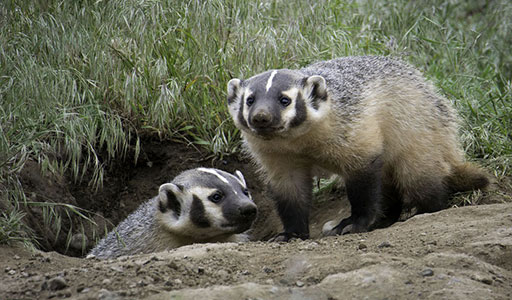Badgers

Badger Information
Badgers may look adorable from a distance with their sweet noses and white stripe down their face. These reddish grey creatures help control rodent population in the wild and around your home. Badgers exist mostly in isolation and are typically just awake during the night. However, these creature’s constant burrowing habits can create a nuisance for home owners around the country, especially in parts of the western United States.

What does a Badger look like?
Growing up to three feet in length, badgers can weigh in excess of 25 pounds. These pests have distinct white stripes that start at their noses and go back over their heads, sometimes trailing all the way to their hindquarters. Other distinguishing features include short, stocky legs, gray to reddish-brown fur, and black patches on their otherwise white faces.

What does a Badger eat?
Badgers have a wide-ranging diet that includes various rodents, ground-nesting birds, lizards, and amphibians. They also feed on carrion, insects, and some plants such as corn. Badgers use their powerful legs and long claws to reach prey under the ground.

Badger habits
Commonly found in fields, pastures, and other open grasslands, badgers dig into the ground to build their dens.
Frequently Asked Questions
These animals weigh up to 25 pounds and have short, stout bodies. In many cases, badger size can be deceiving. These pests like to stay close to the ground, so they often appear smaller than they actually are. Whatever a badger’s size, it is not safe to approach these pests.
Some people try to chase the pests off of their property, but this is also a mistake. Badgers can run 10 to 15 miles per hour and are much more agile than they look. The animals may lunge at threatening people and pets or even chase them a short distance to protect themselves or their young.
While badgers are usually solitary animals, mothers stay with their young for up to six months. These baby badgers are called cubs. Born blind and with thin fur, babies need extra help to survive.
Baby badgers open their eyes after about four weeks. At four months old, females can mate. Males do not reach sexual maturity until they are roughly two years old. The life span of a badger from cub to adulthood is typically five years.
Though they have five toes on each foot, the small inside toes sometimes don’t show up in badger tracks. Additionally, their front feet are significantly larger than their hind feet. Badger tracks are wide and blocky with long front claws that leave marks about three quarters of an inch ahead of the toes. Tracks will have a slight inward rotation due to the animals’ pigeon-toed feet. Front prints are roughly three to four inches long and one to two inches wide. Rear are approximately two inches long and one and a half to two inches wide.
The range of the American badger stretches from the Great Lakes to the Pacific Coast and Canada. Grasslands, prairies, and meadows are typical badger habitats. These animals prefer to use grassy areas for cover while they hunt for rodents and dig up worms.


